Darwin's Children d-2 Read online
Page 31
Cross seemed bemused. “Thank you, Lars. Heartfelt, I’m sure. But I still want to know, where do we go from here?” She hammered her fist on the table with each emphatic word.
Still stuck in his chair in the far corner, pushed back from the table, wearing his trademark gray jacket and yarmulke, Maurie Herskovitz raised his hand. “I think we have a clear-cut problem in epistemology,” he said.
Cross squeezed her eyes shut and pressed the bridge of her nose. “Oh, please, Maurie, anything but that.”
“Hear me out, Marge. Dr. Jackson tried to create a positive, a vaccine against SHEVA and other ERV. He failed. If, as Dr. Morgenstern accuses, Dr. Rafelson came to Americol to demonstrate that no babies would be born if we suppressed their genomic viruses, she has made her point. None have been born. Regardless of her motivations, her work is thorough. It is scientific. Dr. Jackson continues to put forth an hypothesis that the results of his labors seem to have disproved.”
“Maurie, where do we go from here?” Cross repeated, her cheeks pinking.
Herskovitz lifted his hands. “If I could, I would put Dr. Rafelson in charge of viral research at Americol. But that would only be to curse her with more managerial duties and less time in the laboratory. So, I would give her what she needs to conduct her research on her own terms, and let Dr. Jackson focus on what he is best suited for.” He peered happily at Jackson. “Administration. Marge, you and I can make sure he does it right.” Herskovitz then looked at everyone around the room, trying hard to appear serious.
The faces at the table were stony.
Jackson’s skin had turned a bluish shade of ivory. Kaye worried for a second that he might be on the verge of a heart attack. He ticked his pen in a brisk shave-and-a-haircut-two-bits. “I welcome, as always, Dr. Nilson’s and Dr. Herskovitz’s opinions. But I don’t think Americol wants a woman who may be losing her mind in charge of this particular area of research.”
Cross leaned back as if caught in a cold wind. Morgenstern’s watery gaze finally settled on Jackson with an attitude of dread expectancy.
“Dr. Rafelson, last night you spent some hours with our chief radiologist in the imaging lab. I noticed the billing request when I was picking up results from radiology this morning. I asked what the billing was for, and I was told that you were looking for God.”
Kaye managed to hold on to her pencil and not let it drop to the floor. Slowly, she brought her hands up to the tabletop. “I was having an unusual experience,” she said. “I wanted to find out what the cause might be.”
“You told the radiologist you felt God was inside your head. You had been having these experiences for some time, ever since the removal of your daughter by Emergency Action.”
“Yes,” Kaye said.
“Seeing God?”
“I’ve been experiencing certain psychological states,” Kaye said.
“Oh, come on, we’ve just been lectured by Dr. Nilson about truth and honesty. Will you deny your God three times, Dr. Rafelson?”
“What happened was private and has no influence on my work. I am appalled that it should be brought up at this meeting.”
“None of this is relevant? Other than the expense, some seven thousand dollars of unauthorized tests?”
Liz seemed thunderstruck.
“I’m willing to pay for that,” Kaye said.
Jackson lifted a paper-clipped set of invoices and rippled it in the air. “I see no evidence of your picking up the bill.”
Cross’s calm look was replaced by indignant irritation—but at whom, Kaye could not tell. “Is this true?”
Kaye stammered, “It is a personal state of mind, of scientific interest. Almost half—”
“Where will you find God next, Kaye?” Jackson asked. “In your cunning viruses, shuffling around like holy ratchets, obeying rules only you can understand, explaining everything you can’t? If God was my mentor, I’d be thrilled, it would all be so easy, but I am less fortunate. I have to rely on reason. Still, it is an honor to work with someone who can simply ask a higher authority where truth waits to be discovered.”
“Astonishing,” Nilson said. In the corner, Herskovitz sat up. His smile appeared cut in plaster.
“It is not like that,” Kaye said.
“That’s enough, Robert,” Cross said.
Jackson had not moved since beginning his accusation. He sat half-slumped in his chair. “None of us can afford to give up our scientific principles,” he said. “Especially not now.”
Cross stood abruptly. Nilson and Morgenstern looked at Jackson, then at Cross, and got to their feet, pushing back their chairs.
“I have what I need,” Cross said.
“Dr. Rafelson, is God behind evolution?” Jackson called out. “Does he hold all the answers, does he jerk us around like puppets on a string?”
“No,” Kaye said, eyes unfocused.
“Are you really sure, now, in a way none of the rest of us can be, with your special knowledge?”
“Robert, that is enough!” Cross roared. Seldom had any of them heard Cross when she was angry, and her voice was painful in its crackling intensity. She let the stack of papers in her hands slip back to the table and spill onto the floor. She glared at Jackson, then shook her fists at the ceiling. “Absolutely unbelievable!”
“Astonishing,” Nilson repeated, much quieter.
“I apologize,” Jackson said, not at all chastened. His color had returned. He looked vigorous and healthy.
“This is over,” Cross declared. “Everyone go home. Now.”
Liz helped Kaye from the room. Jackson did not deign to look at them as they left.
“What in hell is going on?” Liz asked Kaye in an undertone as they walked toward the elevator.
“I’m fine,” Kaye said.
“What in hell was La Robert on about?”
Kaye did not know where to begin.
22
OREGON
Eileen escorted Mitch down the slope on a crude stairway made of boards hammered into the dirt. As they walked through a copse of pines and up a short embankment, gaining a closer view of the camp, Mitch saw that a large excavation of about ten thousand square feet, L-shaped and covered by two joined Quonset huts, had been hidden by brush arranged over netting. From the air, the entire site would be little more than a smudge in the landscape.
“This looks like a terrorist base, Eileen. How do you conceal the heat signature?” he asked half-seriously.
“It’s going to terrorize North American anthropology,” Eileen said. “That’s for sure.”
“Now you’re scaring me,” Mitch said. “Do I have to sign an NDA or something?”
“I trust you,” Eileen said. She rested a hand on his shoulder.
“Show me now, Eileen, or just let me go home.”
“Where is home?” she asked.
“My truck,” Mitch said.
“That heap?”
Mitch mockingly implored forgiveness with his broad-fingered hands.
Eileen asked, “Do you believe in providence?”
“No,” Mitch said. “I believe in what I see with my eyes.”
“That may take a while. We’re into high-tech survey for now. We haven’t actually pulled up the specimens. We have a benefactor. He’s spending lots of money to help us. I think you’ve heard of him. Here’s his point man now.”
Mitch saw a tent flap open about fifty feet away. A lean, red-headed figure poked out, stood, and brushed dust from his hands. He shaded his eyes and looked around, then spotted the pair on the bluff and lifted his chin in greeting. Eileen waved.
Oliver Merton jogged toward them across the pale, rugged ground.
Merton was the science journalist who had dogged Kaye’s career and footsteps during the SHEVA discoveries. Mitch had never been sure whether to look on Merton as a friend or an opportunist or just a damned fine journalist. He was probably all three.
“Mitch!” Merton called. “How grand to see you again!”
Merton stuck out his hand. Mitch shook it firmly. The writer’s hand was warm and dry and confident. “My god, all Eileen told me was she was going to fetch someone with experience. How absolutely, bloody appropriate. Mr. Daney will be delighted.”
“You always seem to get there ahead of me,” Mitch said.
Merton shaded his eyes against the sun. “They’re having a kind of mid-afternoon powwow, if that’s the right word, back in the tents. Bit of a knockdown, really. Eileen, I think they’re going to decide to uncover one of the girls and take a direct look. You have perfect timing, Mitch. I’ve had to wait days to see anything but videos.”
“It’s a committee decision?” Mitch asked, turning to Eileen.
“I couldn’t stand having all of this on my shoulders,” Eileen confessed. “We have a fine team. Very argumentative. And Daney’s money works wonders. Good beer at night.”
“Is Daney here?” Mitch asked Merton.
“Not yet,” Merton said. “He’s shy and he hates discomfort.” They hunkered their shoulders against a gritty swirl blowing up the gully. Merton wiped his eyes with a handkerchief. “Not his kind of place at all.”
The wide, bush-studded net flapped in the afternoon breeze, dropping bits of dry branch and leaf on them as they stooped to enter the pit. The excavation stretched about forty feet north, then branched east to form an L. Mottled sunlight filtered through the net. They descended four meters on a metal ladder to the floor of the pit.
Aluminum beams crossed the pit at two-meter intervals. Rises in the pit, like little mesas, were topped with wire grids. Over the mesas, some of the beams supported white boxes with lenses and other apparatus jutting from the bottoms. As Mitch watched, the closest box slowly railed right a few centimeters and resumed humming.
“Side scanner?” he asked.
Eileen nodded. “We’ve scraped off most of the mud and we’re peeking through the final layer of tephra. We can see about sixty centimeters into the hard pack.” She walked ahead.
The Quonset structure—arched wooden beams covered by sheets of stamped, ribbed steel and a few milky sheets of fiberglass—sheltered the long stroke of the L. Sunlight poured through the fiberglass sheeting. They walked over flat, hard dirt and haphazard cobbles of river rock between the high, irregular walls. Eileen let Mitch go first, ascending a dirt staircase to the left of a flat-topped rise being surveyed by two more white boxes.
“I don’t dare walk under these damned things,” Eileen said. “I have enough skin blotches as is.”
Mitch knelt beside the mesa to look at alternating layers of mud and tephra, capped by sand and silt. He saw an ash fall—tephra—followed by a lahar, a fast-moving slurry of hot mud made of ash, dirt, and glacier melt. The sand and silt had arrived over time. At the bottom of the mesa, he saw more alternating layers of ash, mud, and river deposits: A deep book going back far longer than recorded history.
“Computers do some really big math and show us a picture of what’s down there,” Eileen said. “We actually debated whether to dig any deeper or just cover it over again and submit the videos and sensor readings. But I guess the committee is going for a traditional invasion.”
Mitch moved his hand in a sweeping motion. “Ash came down for several days,” he said. “Then a lahar swept down the river basin. Up here, it slopped over but didn’t carry off the bodies.”
“Very good,” Merton said, genuinely impressed.
“Want to see our etchings?” Eileen asked.
Eileen unrolled a display sheet in the conference tent and tuned it to her wrist computer. “Still getting used to all this tech,” she murmured. “It’s wonderful, when it works.”
Merton watched over Mitch’s shoulder. Two women in their thirties, dressed in jeans and short-sleeved khaki shirts, stood at the rear of the long, narrow tent, debating in soft but angry voices. Eileen did not see fit to introduce them, which clued Mitch that she was not the only high-powered anthropologist working the dig.
The screen glowed faintly in the tent’s half-light. Eileen told the computer to run a slide show.
“These are from yesterday,” she said. “We’ve done around twenty-seven complete scans. Redundancy upon redundancy, just to be sure we’re not making it up. Oliver says he’s never seen a more frightened bunch of scientists.”
“I haven’t,” Merton affirmed.
The first image showed the pale ghost of a skeleton curled in fetal position, surrounded by what looked like sheets of grass matting, a few stones, and a cloud of pebbles. “Our first. We’re calling her Charlene. As you can see, she’s fairly modern Homo sap. Prominent chin, relatively high forehead. But here’s the tomographic reconstruction from our multiple sweeps.” A second image came up and showed a dolichocephalic, or long-headed, skull. Eileen told the computer to rotate this image.
Mitch scowled. “Looks Australian,” he said.
“She probably is,” Eileen said. “About twenty years of age. Trapped and asphyxiated by hot mud. There are five other skeletons, one close to Charlene, the others clustered about four meters away. All are female. No infants. And no sign of males. The grass matting has decayed, of course. Just molds remain. We have a shadow mold around Charlene, a cast of fine silt from seepage through the mud and ash showing the outlines of her body. Here’s a tomographic image of what that cast would look like, if we could manage to pry it loose from the tephra and the rest of the overburden.”
A distorted ghost of a head, neck, and shoulders appeared and rotated smoothly on the display sheet. Mitch felt odd, standing in a tent that would have been familiar to Roy Chapman Andrews or even to Darwin himself, while staring down at the rolled-out sheet of the computer display.
He asked Eileen to rotate the image of Charlene again.
As the image swung around and around, he began to discern facial features, a closed eye, a blob of ear, hair matted and curled, a hint of cooked and distorted flesh slumped from the back of the skull.
“Pretty awful,” Merton said.
“They suffocated before the heat got to them,” Eileen said. “I hope they did, anyway.”
“Early-stage Tierra del Fuegan?” Mitch asked.
“That’s what most of us think. From the Australian migration out of South and Central America.”
Such migrations had been charted more and more often in the last fifteen years; Australian skeletons and associated artifacts found near the tip of South America had been dated to older than thirty thousand years BP, before the present.
The two other women walked around them to reach the exit, as serious and unsocial as porcupines. A plump, red-faced woman a few years younger than Eileen held the flap open for them then stepped in and stood before Mitch. “Is this the famous Mitch Rafelson?” she asked Eileen.
“Mitch, meet Connie Fitz. I told her I’d bring you here.”
“Delighted to meet you, after all these years.” Fitz wiped her hands on a dusty towel hanging from her belt before shaking hands. “Have you showed him the good stuff?”
“We’re getting there.”
“Best picture of Gertie is on sweep 21,” Fitz advised.
“I know,” Eileen said testily. “It’s my show.”
“Sorry. I’m the mother hen,” Fitz said. “The others are still arguing.”
“Spare me,” Eileen said. Another image cast their faces in a pale greenish light.
“Say hello to Gertie,” Merton said. He glanced up at Mitch, waiting to see his reaction.
Mitch poked the surface of the screen, making the light pool under his finger. He looked up, on the edge of anger. “You’re kidding me. This is a joke.”
“No joke,” Merton said.
Eileen magnified the image. Then, clearing his throat, Mitch asked, “Fraud?”
“What do you think?” Eileen asked.
“They’re in close association? Not in different layers?”
Eileen nodded. “They were buddies, probably traveling together. No infants, but as you can see, Gertie was maybe
fifteen or sixteen, and she was probably gravid when the ash covered her.”
“Either that or she ate babies,” Merton said. Another twitch of the lip from Eileen.
“Oliver’s on borrowed time,” Fitz said.
“Matriarchy,” Merton accused, deadpan.
The tent suddenly seemed very stuffy. Mitch would have sat down had there been a convenient chair. “She looks early. Different from Charlene. Is she a hybrid?” he asked.
“No one’s willing to say,” Eileen replied. “You’ll like our late-night debates. A few weeks back, when I wanted you to join us, everyone shouted me down. Now, we’re all at each other’s throats, and Oliver, I’m told, convinced Daney it was time.”
“I did,” Merton said.
“Personally, I’m glad you’re here,” Eileen added.
“I’m not,” Fitz said. “If the feds find out about you, if there’s any publicity at all, we’re NAGPRA toast.”
“Tell me more, Mitch,” Eileen suggested.
Mitch massaged the back of his neck and for the ninth time watched the image of the skull grow and rotate. “Skull seems compressed. She’s long-headed, more even than the Australian. There’s a flint implement near her hand, and she’s carrying some sort of grass bag over her shoulder, if I’m not mistaken.”
“You’re not.”
“Filled with what looks like bush or small tree roots.”
“Desperation diet,” Fitz said.
“Maybe that was just her assignment, gathering roots for the stone soup.”
Merton looked puzzled. Eileen explained stone soup.
“How colonial,” Merton said.
“Ever the B-movie Brit, aren’t you?” Fitz said.
“Please, children,” Eileen warned.
“Relatively tall, taller than Charlene, maybe, and pretty robust, heavy boned,” Mitch continued, trying to talk himself out of what he was seeing. “Sloping forehead, mid-sized to small brain case, but the face is fairly flat. Impressive supraorbital torus. A bit of a sagittal keel, even an occipital torus. I’d love to get a better look at the incisors.”

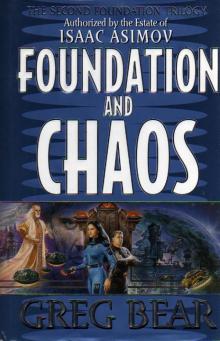 Foundation and Chaos
Foundation and Chaos Halo: Silentium
Halo: Silentium Blood Music
Blood Music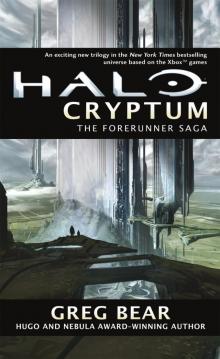 Halo: Cryptum
Halo: Cryptum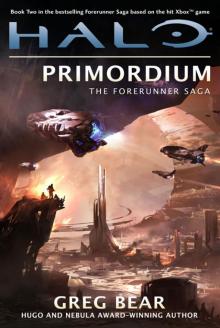 Halo: Primordium
Halo: Primordium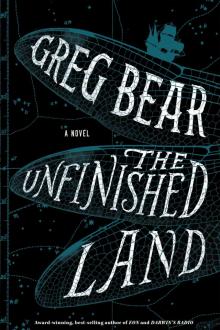 The Unfinished Land
The Unfinished Land Hardfought
Hardfought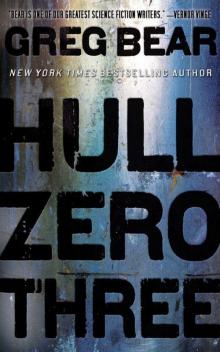 Hull Zero Three
Hull Zero Three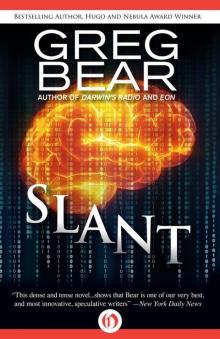 Slant
Slant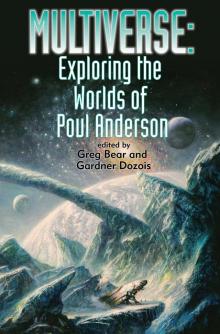 Multiverse: Exploring the Worlds of Poul Anderson
Multiverse: Exploring the Worlds of Poul Anderson Take Back the Sky
Take Back the Sky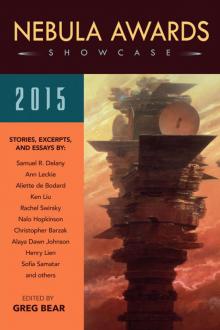 Nebula Awards Showcase 2015
Nebula Awards Showcase 2015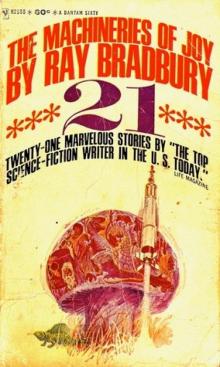 Machineries Of Joy
Machineries Of Joy A Martian Ricorso
A Martian Ricorso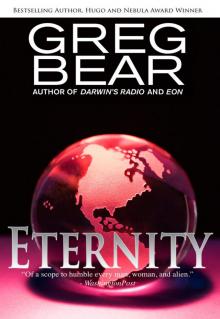 Eternity
Eternity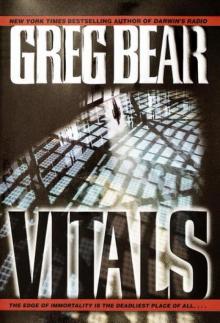 Vitals
Vitals The Infinity Concerto
The Infinity Concerto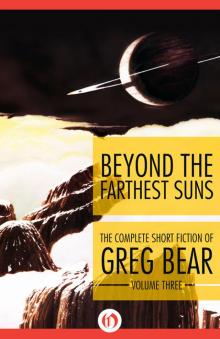 Beyond the Farthest Suns
Beyond the Farthest Suns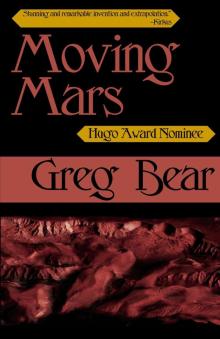 Moving Mars
Moving Mars Quantico
Quantico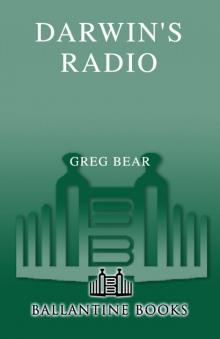 Darwin's Radio
Darwin's Radio Beyond Heaven's River
Beyond Heaven's River Star Wars - Rogue Planet
Star Wars - Rogue Planet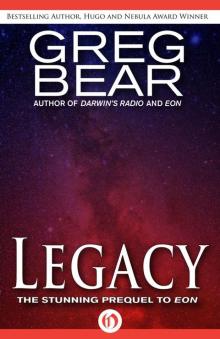 Legacy (Eon, 1)
Legacy (Eon, 1)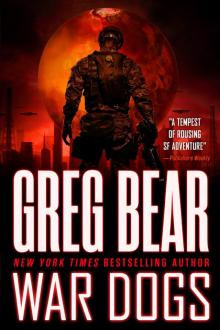 War Dogs: Ares Rising
War Dogs: Ares Rising Sisters
Sisters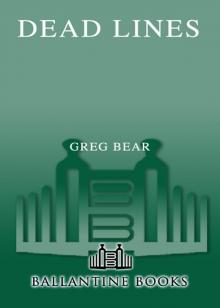 Dead Lines
Dead Lines Just Over the Horizon (The Complete Short Fiction of Greg Bear Book 1)
Just Over the Horizon (The Complete Short Fiction of Greg Bear Book 1) Eon (Eon, 2)
Eon (Eon, 2) Venging
Venging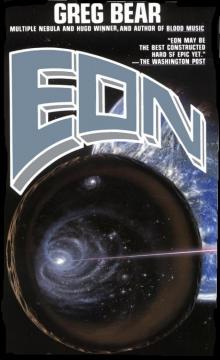 Eon
Eon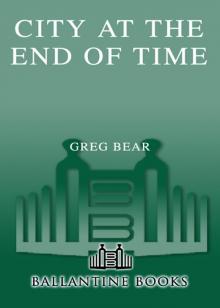 City at the End of Time
City at the End of Time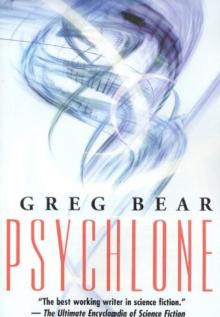 Psychlone
Psychlone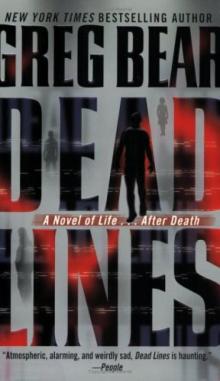 Dead Lines, A Novel of Life... After Death
Dead Lines, A Novel of Life... After Death Eternity (Eon, 3)
Eternity (Eon, 3) Cryptum
Cryptum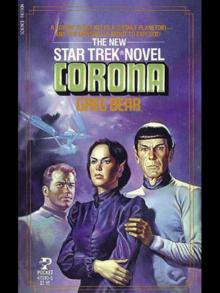 Corona
Corona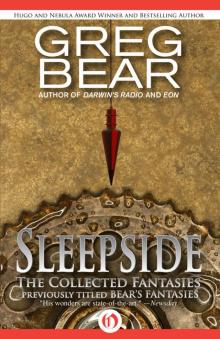 Sleepside: The Collected Fantasies
Sleepside: The Collected Fantasies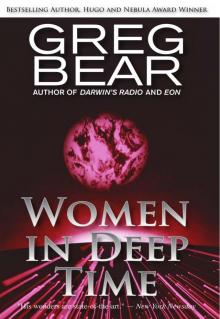 Women in Deep Time
Women in Deep Time Queen of Angels
Queen of Angels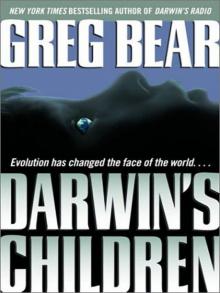 Darwin's Children
Darwin's Children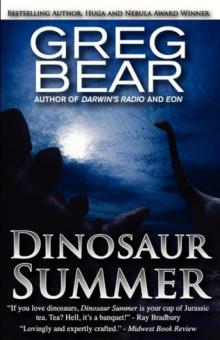 Dinosaur Summer
Dinosaur Summer The Forge of God tfog-1
The Forge of God tfog-1 Foundation and Chaos f-9
Foundation and Chaos f-9 Star Wars: Rogue Planet
Star Wars: Rogue Planet The Forge of God
The Forge of God Mariposa
Mariposa Halo: Cryptum: Book One of the Forerunner Saga
Halo: Cryptum: Book One of the Forerunner Saga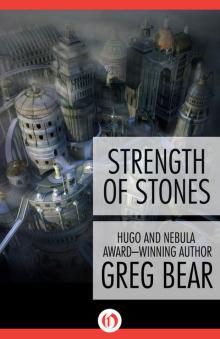 Strength of Stones
Strength of Stones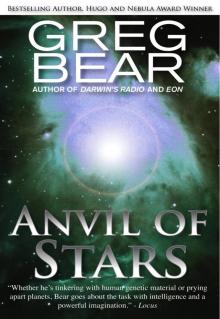 Anvil of Stars
Anvil of Stars B00AQUQDQO EBOK
B00AQUQDQO EBOK Anvil of Stars tfog-2
Anvil of Stars tfog-2 Ares Rising 1: War Dogs
Ares Rising 1: War Dogs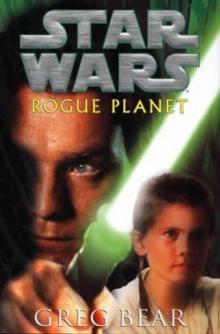 Rogue Planet (star wars)
Rogue Planet (star wars) The Machineries of Joy
The Machineries of Joy Far Thoughts and Pale Gods
Far Thoughts and Pale Gods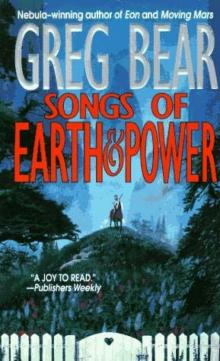 Songs of Earth and Power Omnibus
Songs of Earth and Power Omnibus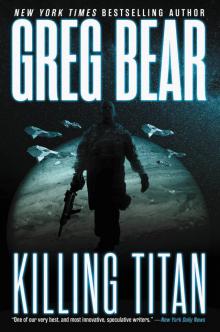 Killing Titan
Killing Titan Darwin's Radio d-1
Darwin's Radio d-1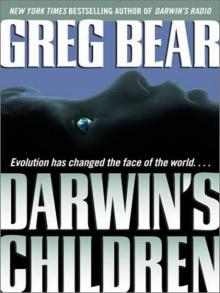 Darwin's Children d-2
Darwin's Children d-2